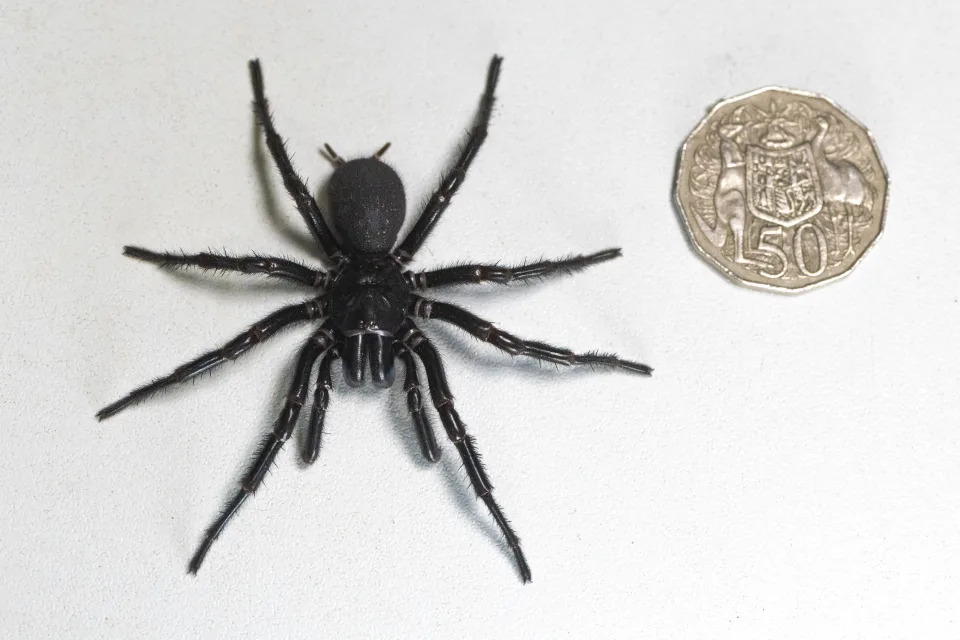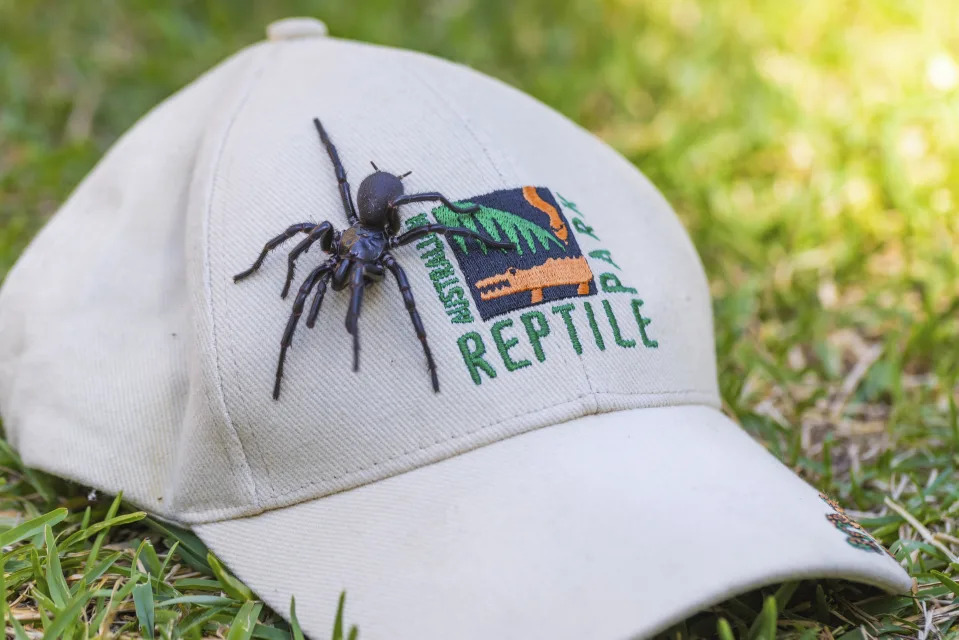WARNING:ARACHNOPHOBIA TRIGGER
The largest male specimen of the world’s most venomous spider has been found in AustraliaOOP'S TOO LATE
Associated Press
Updated Thu, January 4, 2024


Australia Largest Poisonous Spider
In this Dec. 10, 2023 photo supplied by the Australian Reptile Park, a male specimen of the Sydney funnel-web spider, the world's most poisonous arachnid, has been found and donated to the Australian Reptile Park, north of Sydney. The spider, given the name "Hercules", measured 7.9 centimeters (3 inches) from foot to foot, surpassing the park's previous record-holder from 2018, the male funnel-web named "Colossus" and will be used in the reptile park's antivenom program.
Largest Australian funnel web spider donated for antivenom program
Chris Benson
Thu, January 4, 2024

Jan. 4 (UPI) -- A funnel web spider named Hercules, the largest known specimen of its kind, has been donated to the Australian Reptile Park for use in its antivenom program.
The spider -- found and donated by a private individual -- was located on Australia's North South Wales Central Coast. Measuring 3.11 inches, Hercules overtakes the last known largest male funnel web spider, Colossus.
Its venom can kill a human in 15 minutes.
The park, which relies on spider donations, is Australia's only facility that "milks" that particular spider venom. The venom, used to create life saving antivenom, is estimated to save 300 lives a year.
"With having a male funnel web this size in our collection, his venom output could be enormous, proving incredibly valuable for the park's venom program," Emma Teni, one of the park spider keepers, said.
The raw spider venom is shipped to a Melbourne facility and is then made into the life-saving antivenom.
There are 35 types of funnel-web spider species and they are one of the deadliest on Earth. Since the program's 1981 inception, there have not been any reported deaths by a funnel web spider bite.
Associated Press
Updated Thu, January 4, 2024


Australia Largest Poisonous Spider
In this Dec. 10, 2023 photo supplied by the Australian Reptile Park, a male specimen of the Sydney funnel-web spider, the world's most poisonous arachnid, has been found and donated to the Australian Reptile Park, north of Sydney. The spider, given the name "Hercules", measured 7.9 centimeters (3 inches) from foot to foot, surpassing the park's previous record-holder from 2018, the male funnel-web named "Colossus" and will be used in the reptile park's antivenom program.
(Caitlin Vine/Australian Reptile Park via AP)
SYDNEY (AP) — With fangs that could pierce a human fingernail, the largest male specimen of the world's most venomous arachnid has found a new home at the Australian Reptile Park where it will help save lives after a member of the public discovered it by chance.
The deadly Sydney funnel-web spider dubbed “Hercules” was found on the Central Coast, about 50 miles north of Sydney, and was initially given to a local hospital, the Australian Reptile Park said in a statement Thursday.
Spider experts from the nearby park retrieved it and soon realized it was the largest male specimen ever received from the public in Australia.
The spider measured 7.9 centimeters (3.1 inches) from foot to foot, surpassing the park’s previous record-holder from 2018, the male funnel-web named “Colossus".
Sydney funnel-web spiders usually range in length from one to five centimeters, with females being generally larger than their male counterparts but not as deadly. They are predominantly found in forested areas and suburban gardens from Sydney, Australia's most populous city, to the coastal city of Newcastle in the north and the Blue Mountains to the west.
"Hercules" will contribute to the reptile park’s antivenom program. Safely captured spiders handed in by the public undergo “milking” to extract venom, essential for producing life-saving antivenom.
"We’re used to having pretty big funnel-web spiders donated to the park, however receiving a male funnel-web this big is like hitting the jackpot,” said Emma Teni, a spider keeper at Australian Reptile Park. “Whilst female funnel-web spiders are venomous, males have proven to be more lethal.
"With having a male funnel-web this size in our collection, his venom output could be enormous, proving incredibly valuable for the park’s venom program.”
Since the inception of the program in 1981, there has not been a fatality in Australia from a funnel-web spider bite.
Recent rainy, humid weather along Australia's east coast has provided the ideal conditions for funnel-web spiders to thrive.
SYDNEY (AP) — With fangs that could pierce a human fingernail, the largest male specimen of the world's most venomous arachnid has found a new home at the Australian Reptile Park where it will help save lives after a member of the public discovered it by chance.
The deadly Sydney funnel-web spider dubbed “Hercules” was found on the Central Coast, about 50 miles north of Sydney, and was initially given to a local hospital, the Australian Reptile Park said in a statement Thursday.
Spider experts from the nearby park retrieved it and soon realized it was the largest male specimen ever received from the public in Australia.
The spider measured 7.9 centimeters (3.1 inches) from foot to foot, surpassing the park’s previous record-holder from 2018, the male funnel-web named “Colossus".
Sydney funnel-web spiders usually range in length from one to five centimeters, with females being generally larger than their male counterparts but not as deadly. They are predominantly found in forested areas and suburban gardens from Sydney, Australia's most populous city, to the coastal city of Newcastle in the north and the Blue Mountains to the west.
"Hercules" will contribute to the reptile park’s antivenom program. Safely captured spiders handed in by the public undergo “milking” to extract venom, essential for producing life-saving antivenom.
"We’re used to having pretty big funnel-web spiders donated to the park, however receiving a male funnel-web this big is like hitting the jackpot,” said Emma Teni, a spider keeper at Australian Reptile Park. “Whilst female funnel-web spiders are venomous, males have proven to be more lethal.
"With having a male funnel-web this size in our collection, his venom output could be enormous, proving incredibly valuable for the park’s venom program.”
Since the inception of the program in 1981, there has not been a fatality in Australia from a funnel-web spider bite.
Recent rainy, humid weather along Australia's east coast has provided the ideal conditions for funnel-web spiders to thrive.
Largest Australian funnel web spider donated for antivenom program
Chris Benson
Thu, January 4, 2024

Jan. 4 (UPI) -- A funnel web spider named Hercules, the largest known specimen of its kind, has been donated to the Australian Reptile Park for use in its antivenom program.
The spider -- found and donated by a private individual -- was located on Australia's North South Wales Central Coast. Measuring 3.11 inches, Hercules overtakes the last known largest male funnel web spider, Colossus.
Its venom can kill a human in 15 minutes.
The park, which relies on spider donations, is Australia's only facility that "milks" that particular spider venom. The venom, used to create life saving antivenom, is estimated to save 300 lives a year.
"With having a male funnel web this size in our collection, his venom output could be enormous, proving incredibly valuable for the park's venom program," Emma Teni, one of the park spider keepers, said.
The raw spider venom is shipped to a Melbourne facility and is then made into the life-saving antivenom.
There are 35 types of funnel-web spider species and they are one of the deadliest on Earth. Since the program's 1981 inception, there have not been any reported deaths by a funnel web spider bite.
No comments:
Post a Comment